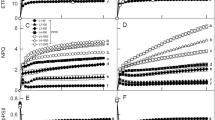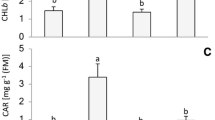Abstract
The quick detection and knowledge on dynamic dissipation of photosynthetic energy processes may improve weed management. This work aimed to evaluate the dynamic dissipation of photosynthetic energy of fleabane (Conyza spp.) upon PSII- and PSI-inhibitor (photosystem I and II) herbicides application. Treatments were comprised of the application of metribuzin (PSII) and paraquat (PSI), following recommended doses for fleabane plants (40 days after germination: 10 to 12 leaves), and an untreated check. Chlorophyll a fluorescence transient was performed at 0.5, 1, 2, 4, 8, 24, 48 and 96 h after application (HAA) and gas exchange analysis was performed at 2, 4 and 96 HAA. Injury symptoms analysis was performed at all previously mentioned time points plus 7, 14, 21, and 28 days after application (DAA). Injury symptoms were observed at 7 DAA and 2 HAA of PSII- and PSI-inhibitors, respectively, while changes in the dynamic dissipation of photosynthetic energy were observed in both cases at 0.5 HAA. At 0.5 and 1 HAA, plants showed a decrease in QA− (quinone) re-oxidation per reaction center and reduction in electron transport yield from QA− to the end electron acceptor of the PSI, for both herbicides. Moreover, plants showed a 90% decline in the performance index and an increase in energy dissipation as heat and fluorescence. Fleabane showed a significant decrease in net assimilation rate (CO2), transpiration rate and stomatal conductance within 1 HAA, for both herbicides. Therefore, PSII- and PSI-inhibitor herbicides presented a rapid negative effect on photosynthetic energy dynamics that can be monitored before the appearance of injury symptoms, which demonstrates the potential use of chlorophyll fluorescence in the rapid screening of metabolic perturbations caused by herbicides.





Similar content being viewed by others
Data availability
The datasets generated during the current study are available from the corresponding author on reasonable request.
References
Alcántara-de la cruz R, de oliveira GM, de Carvalho LB (2020) Herbicide resistance in Brazil: status, impacts, and future challenges. In: Herbicides-current research and case studies in use. IntechOpen. https://doi.org/10.5772/intechopen.91236
Baker NR (2008) Chlorophyll fluorescence: a probe of photosynthesis in vivo. Annu Rev Plant Biol 59:89–113. https://doi.org/10.1146/annurev.arplant.59.032607.092759
Barbagallo RP, Oxborough K, Pallett KE, Baker NR (2003) Rapid, noninvasive screening for perturbations of metabolism and plant growth using chlorophyll fluorescence imaging. Plant Physiol 132:485–493. https://doi.org/10.1104/pp.102.018093
Blainski É, Maciel CDG, Zobiole LHS, Rubin RS, Silva AP, Karpinski RAK, Helvig EO (2015) Eficiência do cloransulam-metílico no controle em pós-emergência de Conyza bonariensis na cultura da soja RR®. Rev Bras Herb 14:235–242. https://doi.org/10.7824/rbh.v14i3.383
Bromilow RH (2004) Paraquat and sustainable agriculture. Pest Manag Sci 60:340–349. https://doi.org/10.1002/ps.823
Brown R, Clapp M, Dyson J, Scott D, Wheals I, Wilks M (2004) Paraquat in perspective. Outlooks Pest Manag 15:259–267
Dayan FE, Zaccaro MLDM (2012) Chlorophyll fluorescence as a marker for herbicide mechanisms of action. Pest Biochem Physiol 102:189–197. https://doi.org/10.1016/j.pestbp.2012.01.005
Duke SO, Dayan FE (2011) Bioactivity of herbicides. In: Murray M-Y (ed) Comprehensive biotechnology, 2nd edn. Elsevier, New York, pp 23–35
Dyer WE, Weller SC (2005) Plant response to herbicides. In: Jenkes MA, Hasegawa PM (eds) Plant abiotic stress. Blackwell Publishing, India, pp 171–214
Foyer CH, Lelandais M, Kunert KJ (1994) Photooxidative stress in plants. Physiol Plant 92:696–717. https://doi.org/10.1111/j.1399-3054.1994.tb03042.x
Frans R (1986) Experimental design and techniques for measuring and analyzing plant responses to weed control practices. Res Methods Weed Sci 29–46
Gharde Y, Singh PK, Dubey RP, Gupta PK (2018) Assessment of yield and economic losses in agriculture due to weeds in India. Crop Prot 107:12–18. https://doi.org/10.1016/j.cropro.2018.01.007
Grillo R, Pereira AE, Nishisaka CS, de Lima R, Oehlke K, Greiner R, Fraceto LF (2014) Chitosan/tripolyphosphate nanoparticles loaded with paraquat herbicide: an environmentally safer alternative for weed control. J Hazard Mater 278:163–171. https://doi.org/10.1016/j.jhazmat.2014.05.079
Hess FD (2000) Light-dependent herbicides: an overview. Weed Sci 48:160–170. https://doi.org/10.1614/0043-1745(2000)048
Islam F, Wang J, Farooq MA, Khan MSS, Xu L, Zhu J, Zhao M, Muños S, Li QX, Zhou W (2018a) Potential impact of the herbicide 2,4-dichlorophenoxyacetic acid on human and ecosystems. Environ Int 111:332–351. https://doi.org/10.1016/j.envint.2017.10.020
Islam F, **e Y, Farooq MA, Wang JW, Yang C, Gill RA, Zhu J, Zhou E (2018b) Salinity reduces 2,4-D efficacy in Echinochloa crusgalli by affecting redox balance, nutrient acquisition, and hormonal regulation. Protoplasma 255:785–802. https://doi.org/10.1007/s00709-017-1159-z
Kaiser YI, Menegat A, Gerhards R (2013) Chlorophyll fluorescence imaging: a new method for rapid detection of herbicide resistance in A lopecurus myosuroides. Weed Res 53:399–406. https://doi.org/10.1111/wre.12043
Kalaji HM, Schansker G, Ladle RJ, Goltsev V, Bosa K, Allakhverdiev SI et al (2014) Frequently asked questions about in vivo chlorophyll fluorescence: practical issues. Photosynth Res 122:121–158
Krause GH, Weis E (1991) Chlorophyll fluorescence and photosynthesis: the basis. Annu Rev Plant Physiol Plant Mol Biol 42:313–349
Leal JFL, Souza ADS, Ribeiro SRDS et al (2020) 2, 4-D and Haloxyfop-P-methyl interaction: sequential and interval applications to effectively control sourgrass (Digitaria insularis L.) and fleabane (Conyza spp. L.). Agron J 112:1216–1226. https://doi.org/10.1002/agj2.20018
Lima GR, Macedo DC, Barros RLN, Machado AFL, Pimentel C (2018) Photosynthetic potential and productivity of common beans under herbicide effect. Planta Daninha 36:e018175606. https://doi.org/10.1590/s0100-8358201836010009
Macedo RS, Lombardi AT, Omachi CY, Rörig LR (2008) Effects of the herbicide bentazon on growth and photosystem II maximum quantum yield of the marine diatom Skeletonema costatum. Toxicol in Vitro 22:716–722. https://doi.org/10.1016/j.tiv.2007.11.012
Medeiros DB, da Luz LM, de Oliveira HO, Araújo WL, Daloso DM, Fernie AR (2019) Metabolomics for understanding stomatal movements. Theor Exp Plant Phys 31:91–102. https://doi.org/10.1007/s40626-019-00139-9
Muller P, Li XP, Niyogi KK (2001) Non-photochemical quenching. a response to excess light energy. Plant Physiol 125:1558–1566. https://doi.org/10.1104/pp.125.4.1558
Oukarroum A, El Madidi S, Schansker G, Strasser RJ (2007) Probing the responses of barley cultivars (Hordeum vulgare L.) by chlorophyll a fluorescence OLKJIP under drought stress and re-watering. Environ Exp Bot 60:438–446. https://doi.org/10.1016/j.envexpbot.2007.01.002
Pinho CF, Leal JFL, Dos Santos SA et al (2019) First evidence of multiple resistance of Sumatran Fleabane (Conyza sumatrensis (Retz.) E. Walker) to five-mode-of-action herbicides. Aust J Crop Sci 13:1688–1697
Powles SB, Yu Q (2010) Evolution in action: plants resistant to herbicides. Annu Rev Plant Biol 61:317–347. https://doi.org/10.1146/annurev-arplant-042809-112119
Santos HG, Jacomine PKT, Anjos LHC et al (2013) Brazilian system of soil classification (in Portuguese). Embrapa Solos, Rio de Janeiro
Savage D, Borger CP, Renton M (2014) Orientation and speed of wind gusts causing abscission of wind-dispersed seeds influences dispersal distance. Funct Ecol 28:973–981. https://doi.org/10.1111/1365-2435.12234
Schansker G, Tóth SZ, Strasser RJ (2005) Methylviologen and dibromothymoquinone treatments of pea leaves reveal the role of photosystem I in the Chl a fluorescence rise OJIP. Biochim Biophys Acta 1706:250–261. https://doi.org/10.1016/j.bbabio.2004.11.006
Sherwani SI, Arif IA, Khan HA (2015) Modes of action of different classes of herbicides. In: Herbicides, physiology of action, and safety. https://doi.org/10.5772/61779
Silva AC, Leonel S, Souza AP, Domingos JR, Ducatti C (2010) Trocas gasosas e ciclo fotossintético da figueira ‘Roxo de Valinhos.’ Cienc Rural 40:1270–1276. https://doi.org/10.1590/S0103-84782010000600005
Soltani N, Dille JA, Burke IC, Everman WJ, Vangessel MJ, Davis VM, Sikkema PH (2016) Potential corn yield losses from weeds in North America. Weed Technol 30:979–984. https://doi.org/10.1614/WT-D-16-00046.1
Sousa CP, De Farias ME, Schock AA, Bacarin MA (2014a) Photosynthesis of soybean under the action of a photosystem II-inhibiting herbicide. Acta Physiol Plant 36:3051–3062. https://doi.org/10.1007/s11738-014-1675-9
Sousa CP, Pinto JJO, Martinazzo EG et al (2014b) Chlorophyll a fluorescence in rice plants exposed of herbicides of group imidazolinone. Planta Daninha 32:141–150. https://doi.org/10.1590/S0100-83582014000100016
Stirbet A, Govindjee (2011) On the relation between the Kautsky effect (chlorophyll a fluorescence induction) and photosystem II: basics and applications of the OJIP fluorescence transient. J Photochem Photobiol B 104:236–257. https://doi.org/10.1016/j.jphotobiol.2010.12.010
Strasser BJ, Strasser RJ (1995) Measuring fast fluorescence transients to address environmental question: the JIP-test. In: Mathis P (ed) Photosynthesis: from light to biosphere. Kluwer Academic, The Netherlands, pp 977–980. https://doi.org/10.1007/978-94-009-0173-5_1142
Strasser RJ, Tsimilli-Michael M, Srivastava A (2004) Analysis of the chlorophyll a fluorescence transient. In: Papageorgiou GC, Govindjee (eds) Chlorophyll a fluorescence: a signature of photosynthesis. Springer, Dordrecht. https://doi.org/10.1007/978-1-4020-3218-9_12
Trebst A (2007) Inhibitors in the functional dissection of the photosynthetic electron transport system. Photosynth Res 92:217–224. https://doi.org/10.1007/s11120-007-9213-x
Tropaldi L, Velini ED, Carbonari CA, Araldi R, Corniani N, Girotto M, Silva IPDF (2015) Detection of crabgrass species tolerance to photosystem II inhibitor herbicides using fluorescence technique. Cien Rural 45:767–773. https://doi.org/10.1590/0103-8478cr20140506
Tsimilli-Michael M, Strasser R (2008) In vivo assessment of stress impact on plants’ vitality: applications in detecting and evaluating the beneficial role of Mycorrhization on host plants. In: Varma A (ed) Mycorrhiza. Springer, Berlin, pp 679–703
Wu H, Walker S, Rollin MJ, Tan DKY, Robinson G, Werth J (2007) Germination, persistence, and emergence of flaxleaf fleabane (Conyza bonariensis [L.] Cronquist). Weed Biol Manag 7:192–199. https://doi.org/10.1111/j.1445-6664.2007.00256.x
Zhang CJ, Lim SH, Kim JW, Nah G, Fischer A, Kim DS (2016) Leaf chlorophyll fluorescence discriminates herbicide resistance in Echinochloa species. Weed Res 56:424–433. https://doi.org/10.1111/wre.12226
Acknowledgements
This study was financed in part by the Coordenação de Aperfeiçoamento de Pessoal de Nível Superior—Brasil (CAPES)—Finance Code 001 and Fundação Carlos Chagas Filho de Amparo à Pesquisa do Estado do Rio de Janeiro (FAPERJ).
Author information
Authors and Affiliations
Corresponding author
Ethics declarations
Conflict of interest
The authors declare that they have no conflict of interest.
Additional information
Communicated by W. Zhou.
Publisher's Note
Springer Nature remains neutral with regard to jurisdictional claims in published maps and institutional affiliations.
Rights and permissions
Springer Nature or its licensor (e.g. a society or other partner) holds exclusive rights to this article under a publishing agreement with the author(s) or other rightsholder(s); author self-archiving of the accepted manuscript version of this article is solely governed by the terms of such publishing agreement and applicable law.
About this article
Cite this article
Leal, J.F.L., Borella, J., dos Santos Souza, A. et al. Photosystem II- and photosystem I-inhibitor herbicides-driven changes in the dynamics of photosynthetic energy dissipation of Conyza spp.. Acta Physiol Plant 45, 94 (2023). https://doi.org/10.1007/s11738-023-03572-1
Received:
Revised:
Accepted:
Published:
DOI: https://doi.org/10.1007/s11738-023-03572-1




